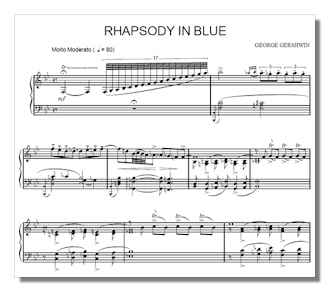
The Internet's Premier Classical Music Source
Related Links
-
Find CDs & Downloads
Amazon - UK - Germany - Canada - France - Japan
ArkivMusic - CD Universe
Find DVDs & Blu-ray
Amazon - UK - Germany - Canada - France - Japan
ArkivMusic-Video Universe
Find Scores & Sheet Music
Sheet Music Plus -
Search Amazon
Recommended Links
Site News
George Gershwin
Rhapsody in Blue (1924)

In 1923 George Gershwin first appeared on the concert stage at New York's Aeolian Hall, accompanying singer Eva Gautier in a program which included American jazz songs. Subsequently Paul Whiteman, who had conducted and was impressed with Blue Monday, asked the young composer for a serious piece to be performed during a concert Whiteman was planning to present with his band in Aeolian Hall. Gershwin promised a piece, and promptly forgot about it. In January, 1924, he was surprised to read in the New York Tribune that Paul Whiteman's concert at Aeolian Hall on February 12th would feature a jazz concerto by George Gershwin. With little time before the concert and occupied with writing the music for Sweet Little Devil, George feared he would be too busy to write anything, but Whiteman persuaded him that he need only write a piano copy and Whiteman's arranger Ferde Grofé‚ would develop the orchestration. On the train to Boston for the tryouts of Sweet Little Devil the plot of his new piece, "which was," he said, "as its title implied, a blues impression," formed in his mind and Gershwin wrote the substance of his music in a week, handing over the pages to Grofé‚ almost as quickly as he finished them.
The Aeolian Hall program was called an "Experiment in Modern Music," and was intended to demonstrate "the tremendous strides which have been made in popular music from the day of discordant Jazz". It opened with several trivial selections, but the audience was delighted by the appearance of George Gershwin at the piano (he improvised the piano part at this first performance) and became electrified at the sound of the opening glissando by Ross Gorman, Whiteman's virtuoso clarinetist. At the end of the piece they broke into enthusiastic applause, although the critics were deeply divided in a polarity about Gershwin's serious music which continued for the remainder of his life.
The Rhapsody in Blue, as Ira Gershwin titled the work, was subsequently arranged for piano and orchestra, as well as for just about every imaginable combination of instruments, and remains the most well-known and popular of all twentieth century American compositions. The Rhapsody was extremely important to the future of American music because it introduced what Rudy Vallée called symphonized syncopation to sophisticated audiences in the serious setting of the concert hall. The Rhapsody in Blue, which owes much to the influence of Liszt, Tchaikovsky, and the Russian music Gershwin heard as a young student, has beautiful, recognizable, and unforgettable melodies, and the entire piece is characterized by Gershwin's energy and rhythmic sense.
Copyright © 1994, 1996 by Jane Erb. All Rights Reserved.













